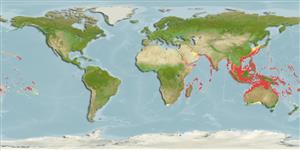>
Carangiformes (Jacks) >
Carangidae (Jacks and pompanos) > Caranginae
Etymology: Caranx: French, carangue, the name of a Caribbean fish; 1836 (Ref. 45335).
More on author: Forsskål.
Environment: milieu / climate zone / depth range / distribution range
Ecologia
marinhas; estuarina associadas(os) a recifes; intervalo de profundidade 10 - 188 m (Ref. 58302). Tropical; 26°C - 29°C; 35°N - 37°S, 19°E - 129°W
Indo-Pacific: Red Sea and east coast of Africa to the Hawaiian and Marquesan islands, north to southern Japan (Ref. 559) and the Ogasawara Islands, south to northern Australia. Hybrid with Caranx melampygus found in Hawaii (Ref. 58422).
Comprimento de primeira maturação / Tamanho / Peso / Idade
Maturity: Lm 60.0 range ? - ? cm
Max length : 170 cm TL macho/indeterminado; (Ref. 9710); common length : 100.0 cm TL macho/indeterminado; (Ref. 5213); peso máx. publicado: 80.0 kg (Ref. 4795)
Espinhos dorsais (total) : 9; Raios dorsais (total) : 18 - 21; Espinhos anais: 3; Raios anais : 15 - 17; Vértebras: 24. This species is distinguished by the following characters: gill rakers (including rudiments) 5-7 + 15-17 = 20-24; breast naked ventrally, typically with a small to large patch of prepelvic scales; colour in life of adults, head and body silvery grey to black above, usually paler below; fins usually uniformly grey to black, fish from turbid coastal waters often with yellow fins, the anal fin usually brightest (Ref. 9894).
Adults are pelagic over sand and rock (Ref. 58302). They occur singly and inhabit clear lagoon and seaward reefs (Ref. 9710). They feed on crustaceans (like crabs and spiny lobsters) and fishes at night (Ref. 4887). Juveniles are found in estuaries. Large individuals may be ciguatoxic. The largest trevally reaches 1.7 m in length and a weight of over 60 kg (Ref. 48635). Spawning occurs on shallow seaward reefs and offshore banks (Ref. 37816). Sold mostly fresh and dried salted.
Ciclo de vida ou comportamento de acasalamento
Maturities | Reprodução | Spawnings | Egg(s) | Fecundities | Larvas
Paxton, J.R., D.F. Hoese, G.R. Allen and J.E. Hanley, 1989. Pisces. Petromyzontidae to Carangidae. Zoological Catalogue of Australia, Vol. 7. Australian Government Publishing Service, Canberra, 665 p. (Ref. 7300)
Status na Lista Vermelha da UICN (Ref. 130435)
Ameaça para os humanos
Reports of ciguatera poisoning (Ref. 9710)
Uso pelos humanos
Pescarias: espécies comerciais; Aquacultura: espécies comerciais; peixe esportivo: sim; Aquário: Aquários públicos
Ferramentas
Relatórios especiais
Baixar XML
Fontes da internet
Estimates based on models
Preferred temperature (Ref.
123201): 21.2 - 28.4, mean 26.8 °C (based on 1154 cells).
Índice de diversidade filogenética (Ref.
82804): PD
50 = 0.5000 [Uniqueness, from 0.5 = low to 2.0 = high].
Bayesian length-weight: a=0.01862 (0.01559 - 0.02224), b=2.95 (2.92 - 2.98), in cm total length, based on LWR estimates for this species (Ref.
93245).
Nível Trófico (Ref.
69278): 4.2 ±0.4 se; based on diet studies.
Generation time: 13.7 ( na - na) years. Estimated as median ln(3)/K based on 2
growth studies.
Resiliência (Ref.
120179): médio(a), tempo mínimo de duplicação da população 1,4 - 4,4 anos (K=0.08-0.11; tm=3.5).
Prior r = 0.56, 95% CL = 0.37 - 0.83, Based on 2 data-limited stock assessments.
Fishing Vulnerability (Ref.
59153): High to very high vulnerability (74 of 100).
Climate Vulnerability (Ref.
125649): High to very high vulnerability (72 of 100).
Nutrients (Ref.
124155): Calcium = 10.8 [4.6, 21.4] mg/100g; Iron = 0.288 [0.152, 0.572] mg/100g; Protein = 20.1 [17.8, 22.6] %; Omega3 = 0.122 [0.069, 0.211] g/100g; Selenium = 62.5 [30.3, 131.1] μg/100g; VitaminA = 56.9 [15.4, 194.6] μg/100g; Zinc = 0.476 [0.338, 0.698] mg/100g (wet weight);
